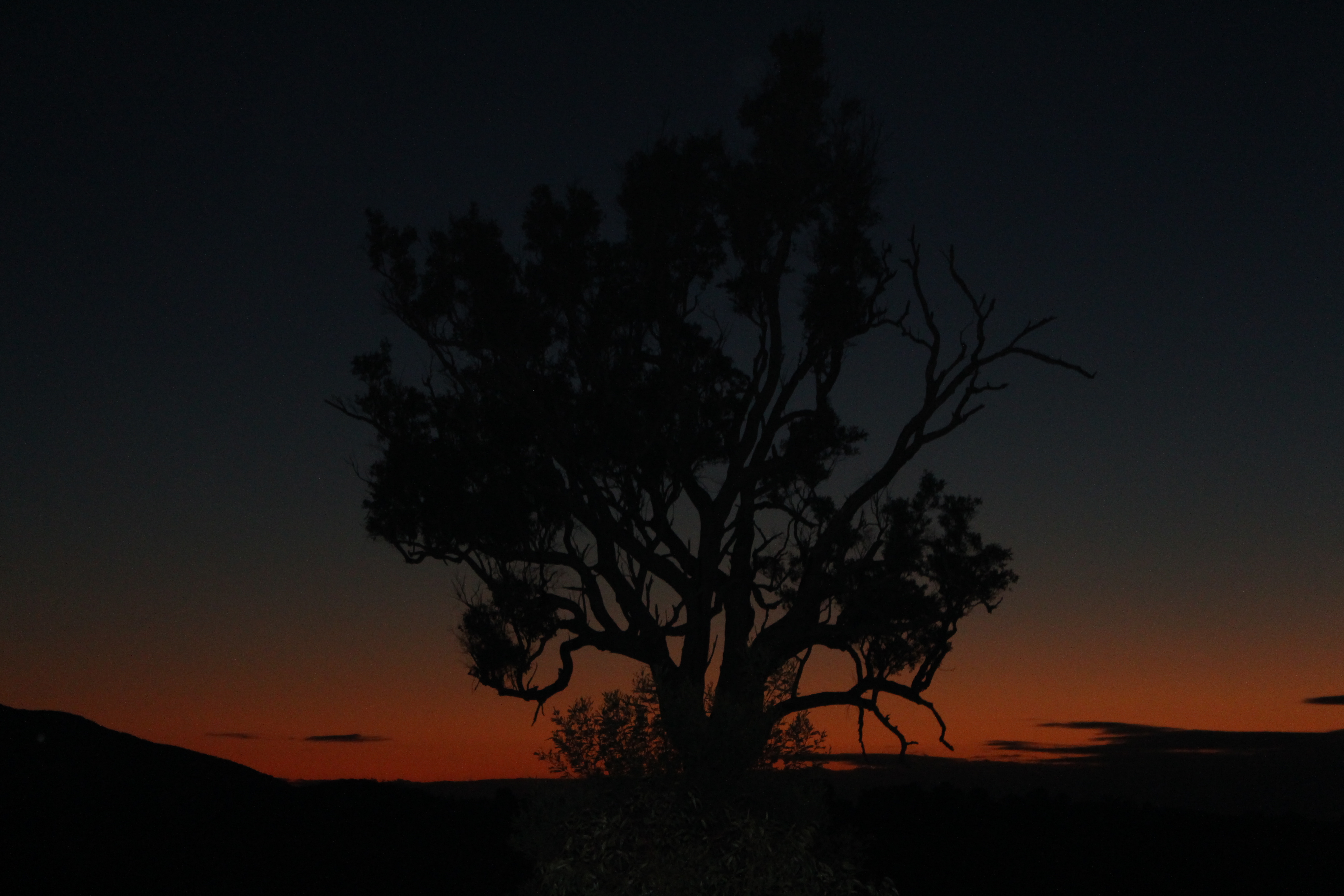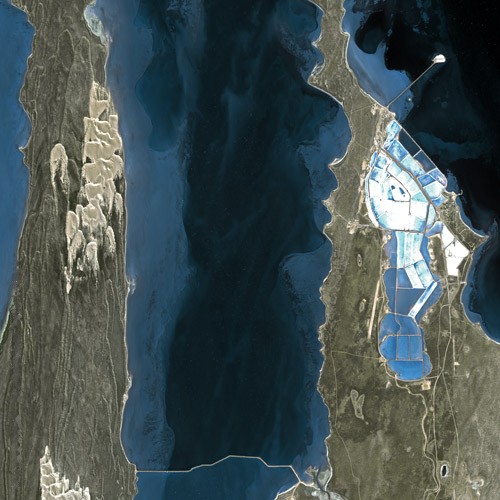|
Eucalyptus Mannensis
''Eucalyptus mannensis'', commonly known as Mann Range mallee, is a species of mallee that is native to Western Australia, South Australian and the Northern Territory. It has rough bark at the base of the trunk, smooth bark above, narrow lance-shaped adult leaves, flower buds in groups of between seven and eleven, creamy white flowers and hemispherical fruit. Description ''Eucalyptus mannensis'' is a mallee, rarely a straggly tree, that typically grows to a height of and forms a lignotuber. It has rough, flaky or fibrous bark on the lower part of the trunk, smooth greyish bark above. Young plants and coppice regrowth have dull, greyish green, lance-shaped leaves that are long and wide. Adult leaves are the same shade of glossy green on both sides, narrow lance-shaped to narrow elliptical, long and wide, tapering to a petiole long. The flower buds are arranged in leaf axils in groups of seven, nine or eleven on an unbranched peduncle long, the individual buds on pedicel ... [...More Info...] [...Related Items...] OR: [Wikipedia] [Google] [Baidu] |
Clifford David Boomsma
Clifford David Boomsma (20 October 1915 – 13 January 2004) was an Australian forester, botanist and botanical collector. Boomsma was born in Gawler in South Australia in 1915 and became a ward of the state at three years of age. He completed his early schooling in Mylor in the Adelaide hills He was later sponsored and attended high school at Scotch College as a boarder. Following graduation he attended Adelaide University completing a Bachelor of Science then went on to study Forestry at the Australian Forestry School, Canberra where he graduated in 1939. He worked at Penola forest and then at Mount Burr forests for the Department of Woods and Forests and was eventually posted to the Adelaide head office. He later completed his master's degree on the ecology of Fleurieu Peninsula as well as other regions in South Australia and continued working as a forester for the Woods and Forests department for the remainder of his career and wrote several books on the native trees and ... [...More Info...] [...Related Items...] OR: [Wikipedia] [Google] [Baidu] |
Australian Plant Census
The Australian Plant Census (APC) provides an online interface to currently accepted, published, scientific names of the vascular flora of Australia, as one of the output interfaces of the national government Integrated Biodiversity Information System (IBIS – an Oracle Co. relational database management system). The Australian National Herbarium, Australian National Botanic Gardens, Australian Biological Resources Study and the Council of Heads of Australasian Herbaria coordinate the system. The Australian Plant Census interface provides the currently accepted scientific names, their synonyms, illegitimate, misapplied and excluded names, as well as state distribution data. Each item of output hyperlinks to other online interfaces of the information system, including the Australian Plant Name Index (APNI) and the Australian Plant Image Index (APII). The outputs of the Australian Plant Census interface provide information on all native and naturalised vascular plant taxa ... [...More Info...] [...Related Items...] OR: [Wikipedia] [Google] [Baidu] |
Flora Of South Australia
Flora (: floras or florae) is all the plant life present in a particular region or time, generally the naturally occurring ( indigenous) native plants. The corresponding term for animals is ''fauna'', and for fungi, it is ''funga''. Sometimes bacteria and fungi are also referred to as flora as in the terms ''gut flora'' or ''skin flora''. Etymology The word "flora" comes from the Latin name of Flora, the goddess of plants, flowers, and fertility in Roman mythology. The technical term "flora" is then derived from a metonymy of this goddess at the end of the sixteenth century. It was first used in poetry to denote the natural vegetation of an area, but soon also assumed the meaning of a work cataloguing such vegetation. Moreover, "Flora" was used to refer to the flowers of an artificial garden in the seventeenth century. The distinction between vegetation (the general appearance of a community) and flora (the taxonomic composition of a community) was first made by Jules Thurman ... [...More Info...] [...Related Items...] OR: [Wikipedia] [Google] [Baidu] |
Plants Described In 1964
Plants are predominantly photosynthetic eukaryotes of the kingdom Plantae. Historically, the plant kingdom encompassed all living things that were not animals, and included algae and fungi; however, all current definitions of Plantae exclude the fungi and some algae, as well as the prokaryotes (the archaea and bacteria). By one definition, plants form the clade Viridiplantae (Latin name for "green plants") which is sister of the Glaucophyta, and consists of the green algae and Embryophyta (land plants). The latter includes the flowering plants, conifers and other gymnosperms, ferns and their allies, hornworts, liverworts, and mosses. Most plants are multicellular organisms. Green plants obtain most of their energy from sunlight via photosynthesis by primary chloroplasts that are derived from endosymbiosis with cyanobacteria. Their chloroplasts contain chlorophylls a and b, which gives them their green color. Some plants are parasitic or mycotrophic and have lost the abili ... [...More Info...] [...Related Items...] OR: [Wikipedia] [Google] [Baidu] |
Myrtales Of Australia
The Myrtales are an order of flowering plants placed as a sister to the eurosids II clade as of the publishing of the ''Eucalyptus grandis'' genome in June 2014. The APG III system of classification for angiosperms still places it within the eurosids. This finding is corroborated by the placement of the Myrtales in the Malvid clade by the One Thousand Plant Transcriptomes Initiative. The following families are included as of APGIII: * Alzateaceae S. A. Graham * Combretaceae R. Br. ( leadwood family) * Crypteroniaceae A. DC. * Lythraceae J. St.-Hil. ( loosestrife and pomegranate family) * Melastomataceae Juss. (including Memecylaceae DC.) * Myrtaceae Juss. (myrtle family; including Heteropyxidaceae Engl. & Gilg, Psiloxylaceae Croizat) * Onagraceae Juss. ( evening primrose and Fuchsia family) * Penaeaceae Sweet ex Guill. (including Oliniaceae Arn., Rhynchocalycaceae L. A. S. Johnson & B. G. Briggs) * Vochysiaceae A. St.-Hil. The Cronquist system gives essentially the same c ... [...More Info...] [...Related Items...] OR: [Wikipedia] [Google] [Baidu] |
Eucalyptus
''Eucalyptus'' () is a genus of over seven hundred species of Flowering plant, flowering trees, shrubs or Mallee (habit), mallees in the Myrtaceae, myrtle Family (biology), family, Myrtaceae. Along with several other genera in the Tribe (biology), tribe Eucalypteae, including ''Corymbia'', they are commonly known as eucalypts. Plants in the genus ''Eucalyptus'' have bark that is either smooth, fibrous, hard or stringy, leaves with oil Gland (botany), glands, and sepals and petals that are fused to form a "cap" or Operculum (botany), operculum over the stamens. The fruit is a woody Capsule (botany), capsule commonly referred to as a "gumnut". Most species of ''Eucalyptus'' are Indigenous (ecology), native to Australia, and every state and territory has representative species. About three-quarters of Australian forests are eucalypt forests. Wildfire is a feature of the Australian landscape and many eucalypt species are adapted to fire, and resprout after fire or have seeds which sur ... [...More Info...] [...Related Items...] OR: [Wikipedia] [Google] [Baidu] |
Eucalypts Of Western Australia
Eucalypt is a descriptive name for woody plants with capsule fruiting bodies belonging to seven closely related genera (of the tribe Eucalypteae) found across Australasia: ''Eucalyptus'', ''Corymbia'', ''Angophora'', '' Stockwellia'', '' Allosyncarpia'', '' Eucalyptopsis'' and ''Arillastrum''. Taxonomy For an example of changing historical perspectives, in 1991, largely genetic evidence indicated that some prominent ''Eucalyptus'' species were actually more closely related to ''Angophora'' than to other eucalypts; they were accordingly split off into the new genus ''Corymbia''. Although separate, all of these genera and their species are allied and it remains the standard to refer to the members of all seven genera ''Angophora'', ''Corymbia'', ''Eucalyptus'', ''Stockwellia'', ''Allosyncarpia'', ''Eucalyptopsis'' and ''Arillastrum'' as "eucalypts" or as the eucalypt group. The extant genera ''Stockwellia'', ''Allosyncarpia'', ''Eucalyptopsis'' and ''Arillastrum'' comprise six ... [...More Info...] [...Related Items...] OR: [Wikipedia] [Google] [Baidu] |
List Of Eucalyptus Species
The following is an alphabetical list of ''Eucalyptus'' species accepted by the Australian Plant Census as at February 2019. Several species only occurring outside Australia, including '' E. orophila'', '' E. urophylla'' and '' E. wetarensis'' are listed at the World Checklist of Selected Plant Families. A * '' Eucalyptus abdita'' Brooker & Hopper * ''Eucalyptus absita'' Grayling & Brooker – Badgingarra box * '' Eucalyptus acaciiformis'' H.Deane & Maiden – wattle-leaved peppermint * ''Eucalyptus accedens'' W.Fitzg. – powderbark wandoo * '' Eucalyptus acies'' Brooker – Woolburnup mallee * ''Eucalyptus acmenoides'' Schauer in W.G.Walpers – white mahogany * '' Eucalyptus acroleuca'' L.A.S.Johnson & K.D.Hill – Lakefield coolibah * '' Eucalyptus adesmophloia'' (Brooker & Hopper) D.Nicolle & M.E.French * '' Eucalyptus aequioperta'' Brooker & Hopper – Welcome Hill gum * ''Eucalyptus agglomerata'' Maiden – blue-leaved stringybark * ''Eucalyptus aggregata'' H.Deane & Ma ... [...More Info...] [...Related Items...] OR: [Wikipedia] [Google] [Baidu] |
Department Of Parks And Wildlife (Western Australia)
The Department of Parks and Wildlife (DPaW) was the department of the Government of Western Australia responsible for managing lands described in the ''Conservation and Land Management Act 1984'' and implementing the state's conservation and environment legislation and regulations. The minister responsible for the department was the Minister for the Environment (Western Australia), Minister for the Environment. History The Department of Environment and Conservation (Western Australia), Department of Environment and Conservation (DEC) was separated on 30 June 2013, forming the Department of Parks and Wildlife (DPaW) and the Department of Environment Regulation (DER), both of which commenced operations on 1 July 2013. DPaW focused on managing multiple use state forests, national parks, marine parks and reserves. DER focused on environmental regulation, approvals and appeals processes, and pollution prevention. It was announced on 28 April 2017 that the Department of Parks and Wi ... [...More Info...] [...Related Items...] OR: [Wikipedia] [Google] [Baidu] |
Murchison River (Western Australia)
The Murchison River is the second longest river in Western Australia. It flows for about from the southern edge of the Robinson Ranges to the Indian Ocean at Kalbarri. The Murchison-Yalgar-Hope river system is the longest river system in Western Australia. It has a mean annual flow of 208gigalitres, although in 2006, the peak year on record since 1967, flow was 1,806gigalitres. Basin The Murchison River basin covers an area of about in the Mid West region of Western Australia. It extends about inland from the Indian Ocean, onto the Yilgarn Craton east of Meekatharra and north of Sandstone. Rain generally falls in the upper basin during summer cyclones, so for much of the year the Murchison River does not flow, leaving a dry sandy river bed and intermittent permanent pools. The eastern reaches of the basin contain large chains of salt lakes, which flow only following rainfall. The drainage lines from these lakes merge to form the Murchison River about north-northea ... [...More Info...] [...Related Items...] OR: [Wikipedia] [Google] [Baidu] |
Shark Bay
Shark Bay ( Malgana: ''Gathaagudu'', "two waters") is a World Heritage Site in the Gascoyne region of Western Australia. The http://www.environment.gov.au/heritage/places/world/shark-bay area is located approximately north of Perth, on the westernmost point of the Australian continent. UNESCO's official listing of Shark Bay as a World Heritage Site reads: : History The record of Australian Aboriginal occupation of Shark Bay extends to years BP. At that time most of the area was dry land, rising sea levels flooding Shark Bay between BP and BP. A considerable number of aboriginal midden sites have been found, especially on Peron Peninsula and Dirk Hartog Island which provide evidence of some of the foods gathered from the waters and nearby land areas. An expedition led by Dirk Hartog happened upon the area in 1616, becoming the second group of Europeans known to have visited Australia. (The crew of the '' Duyfken'', under Willem Janszoon, had visited Cape York in 1606 ... [...More Info...] [...Related Items...] OR: [Wikipedia] [Google] [Baidu] |







